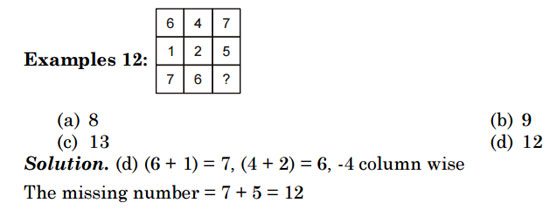Study Materials for IBPS, Bank Exams : Mental Ability/Reasoning : Mathematical Operations
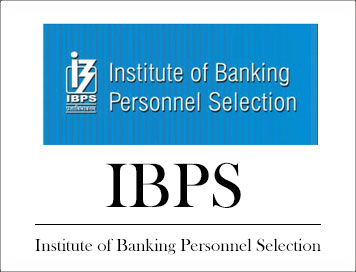
Study Materials for IBPS, Bank Exams : Mental Ability/Reasoning : Mathematical Operations
The basic approach for the problems of this type is more or less similar to that of coding and decoding. One has to study the symbols or the geometrical figures and their meanings carefully. Then, the meanings are to be used in place of those symbols in answering the questions.
The questions can be categorised into two types Symbols and Notations
Symbols and Notations
Symbols for these types of questions stand for mathematical operations like +, –, ×, ÷, > , <, ³, £, = and #. So, the studentsmust replace the symbols by mathematical operations and apply the BODMAS’ rule to find the value of the given expression. Other symbols which can be used are DÑ, *, @, $, etc, with proper definitions. Some examples are given below
Example 1: If ‘+’ means ‘–’, ‘–’ means ‘×’, ‘×’ means and ‘means’ ‘÷’, and ‘÷’ mean ‘+’ then 15 × 3 ÷ 15 + 5 – 2 = ?
(a) 0
(b) 10
(c) 20
(d) 6
Solution. (b): 15 × 3 = 15 + 5 – 2 after changing the signs = 15 = 3 + 15 – 5 × 2 = 5 + 15 – 10 =10
Example 2: If 2 * 3 = 12, 3 * 4 = 20 and 4 * 5 = 30, then 2 * 6 is
(a) 18
(b) 12
(c) 21
(d) None of these
Solution. (c) The numbers on both sides of * are increased by one and then multiplied to get the answer. 2*6 = 3 × 7 = 21
Example 3: If x $ y = (x + y + xy –1) (x + y + xy + 1), then the value of (4 $ 10) is.
(a) 2915
(b) 2195
(c) 2951
(d) 2955
Solution. (a) As per the definition of $, (4$10) would be (4 + 10 + 4 × 10 - 1) (4 + 10 + 4 × 10 + 1) = 2915. So, answer is (a)
Example 4: If * means “is greater than”, @ means `is less then’; and $ means “is equal to” and if a $ b and b @ c, then
(a) c * b
(b) b * c
(c) c * a
(d) Both (a) and (c)
Solution. (d) Replace the symbols with the meaning given against them. If a $ b and b @ c would become a = b and b < c, then c > b or c > a ie, c * b, c * a are true from the given options.
Geometrical Figures
These figures will be divided and subdivided into a number of parts, each part is filled with a number or a letter except one part. The numbers or the letters in the figures follow certain pattern. The objective is to identify the pattern and find the missing number or letter. The problems based on geometrical figures are of various types.
Type 1
Based on circles: In these type of, three circles with numbers outside the
circle will be given. In the firsttwo circles, the number inside the circle is
written according to a particular pattern. The objective of the student is to
find the missing number of third circle.
Example 5:
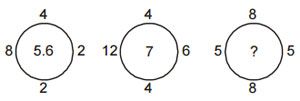
(a) 7.16
(b) 9.25
(c) 6.23
(d) 8.33
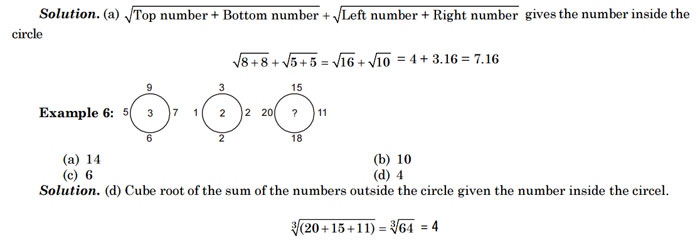
Type 2
Circle divided into parts: In such questions, circle is divided into three parts. An arithmetic operation on the numbers gives the missing number

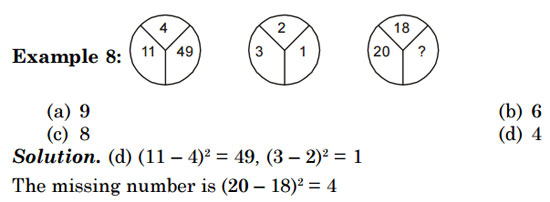
Type 3
Problems based on triangles: In such questions, three triangles are given with numbers inside and outside. The number inside the triangle is obtained by operating some arithmetic operators on the numbers outside the triangle.

Type 4
Problems based on squares: Such questions consist of three squares with five
numbers inside the square of the 5 numbers, 4 numbers are at the four corners of
the square and one middle number follow some arithmetic
operation.
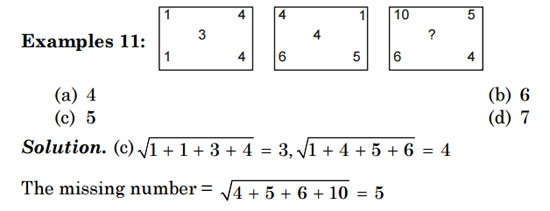
Type 5
Problems based on matrix: In such questions, a square divided into nine
parts, three rows and three columns, out of the nine parts, eight parts are
filled with one part left vacant. The students need to apply some
arithmetic operation to find out the missing number.
